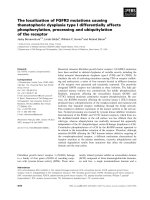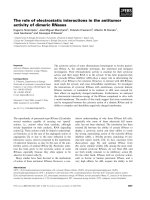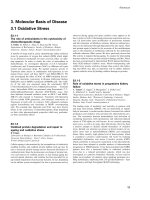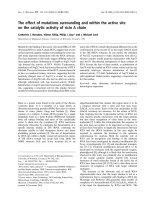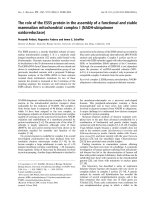báo cáo khoa học: " The acceptability of nicotine containing products as alternatives to cigarettes: findings from two pilot studies" potx
Bạn đang xem bản rút gọn của tài liệu. Xem và tải ngay bản đầy đủ của tài liệu tại đây (249.92 KB, 7 trang )
RESEARCH Open Access
The acceptability of nicotine containing products
as alternatives to cigarettes: findings from two
pilot studies
Ron Borland
1*
, Lin Li
1
, Kevin Mortimer
2
, Ann McNeil
2
, Bill King
1
and Richard J O’Connor
3
Abstract
Background: This study aimed to explore issues that might impact on the acceptability and feasibility of offering
smokers nicotine containing products either to quit nicotine use altogether by using as a short term means of
quitting cigarettes or as a longer term substitute.
Method: Two small pilot studies, one in the UK (n = 34) involving face to face contact and direct provision of the
product, the other in Australia (n = 31) conducted remotely with products sent in the mail.
Results: Nicotine lozenges were the most popular products, but significant minorities liked a smokeless product
more. Use stimulated interest in quitting, and although many failed to use all the products provided, most were
interested in future use, more often to help quit than as a planned long-term substitute.
Conclusions: These studies indicate an untapped interest in the use of substitutes to reduce the harmfulness of
smoking. Studies of this sort do not inhibit interest in quitting nicotine altogether, and may facilitate it. The greater
the range of products on offer, the more smokers are likely to try a product to quit.
Background
Harm reduction, or encouraging cigarette smokers to
move toward less hazardous forms of nicotine delivery,
is a potential means to reduce the overall morbidity and
mortality associated with smoking. Martin et al (2004)
identified 5 characteristics harm reducing products
should have: substa ntial disease reduction, minimal
unintended (adverse) consequences, no combustion and
large reduction in toxins, acceptable to consumers, and
documented scientific basis for harm reduction [1].
Nicotine replacement therapy (NRT) products are the
first obvious potential substitutes, however, there are
concerns about consumer acc eptability for long-term
use [1]. While some forms of smokeless tobacco are
quite toxic, others have toxicant profiles similar to that
of NRT, so an alternative strategy would be to consider
the lower toxicant versions of smokeless tobacco, if
NRT was not acceptable to them. The viability of these
strategies hinges in part on how likely cigarett e smokers
would be to use them, how much reduction in harm we
might expect, and w hether introducing such products
would prolong tobacco use or even encourage new use,
and the likely net effects of these forces.
If substitution was to be a viable strategy, smokers
would need to be convinced to try such products and to
use them for long enough to establish whether they
were an adequate substitute for cigarettes. There are an
increasing number of small studies testing smokers’ will-
ingness to switch to smokeless or long term use of NRT
[2-5]. Rennard et al reported modest continued partici-
pation and low rates of quitting cigarettes in a year long
study of use of the nicotine inhaler to reduce or enable
quitting of smoking [6]. The 20% who continued inhaler
use did manage to sustain large reductions in cigarette
consumption. This is consistent with the view that cur-
rent NRT products may not be sufficiently attractive to
wean most smokers off cigarettes, but that at least some
smokers will persist in using a partial substitute. O’Con-
nor and colle agues showed that US smokers offered the
opportunity to sample a range of oral nicotine products
used them primarily for partial substitution (i.e. they
continued to smoke, but fewer cigarettes per day) [5].
* Correspondence:
1
VicHealth Center for Tobacco Control, The Cancer Council Victoria, Carlton
3053, Australia
Full list of author information is available at the end of the article
Borland et al. Harm Reduction Journal 2011, 8:27
/>© 2011 Borland et al; licensee BioMed Central Ltd. This is an Open Access article distributed u nder the terms of the Creative Commons
Attribution License (http: //creativecommons.org/licenses/by/2.0), which permits unrestricted use, distri bution, and reproduction in
any medium, p rovided the original work is properly cited.
More smokers in this study preferred a nicotine replace-
ment product than a tobacco-based product.
In a companion paper (Borland R, Li L, Cummings
KM, O’Connor R, Mortimer K, & Wikmans T, McNeill
A, King B: Effects of a fact sheet on beliefs about the
harmfulness of alternative nicotine delivery syst ems
compared with cigarettes. Submitted)., we showed that
providing information to smokers (including the samples
studied here) increased their understanding of the
greater harms of cigarettes compared to both smokeless
tobacco (ST) and NRT products. We believed it is
essential to provide this information in studies of such
products to help smokers understand why health-
oriented researchers would be interested in getting them
to try them for potential use.
This paper reports on two pilot studies designed to
assess the feasibility of offering smokers alternative nico-
tine products to consider for use to quit smoking or as a
long-term substitute for cigarettes. The aim is to assess
preparedness to use alternatives, both short term and
longer term. Subsidiary aims are to test out methods
and to undertake preliminary assessment of the promise
of various NRT and ST products, and to obtain esti-
matesofpossibleeffectsizesforpoweringaproposed
comprehensive test of the likely outcomes of promo ting
these products in preference to cigarettes (and other
smoked products).
Methods
Participants
The two studies recruited smokers in very different
ways. In the UK respondents were interviewed face to
face after responding to a newspaper advertisement
seeking adult smokers interested in a study on alterna-
tives to cigarettes. In Australia, the entire study was
done by telephone and internet, with respondents to an
anonymous survey a bout the harms of smoking invited
into this study if they met the inclusion criteria. Partici-
pants then needed to identify themselves and return a
signed consent form.
Inclusion criteria for both studies were being adults,
daily smokers of 10 or more cigarettes per day, not
planning to quit smoking in the next month, and
reporting no regular use of medication for mental health
issues. Participants also had to complete two preliminary
surveys on knowledge and attitudes between which they
were given a fact sheet explaining the relative harms of
nicotine-containing products including cigarettes and
the mechanisms by which c igare ttes and other nicotine
products had their harmful effects (see Borland et al,
submitted, for details).
Characteristics of both samples can be found in
Table 1. In the UK 43 of 77 eligible smokers accepted
the offer to participate and consented and 34 (79%)
tried at least one product and completed the final
questionnaire.
Of those eligible to participate (and invited), 36 of 62
in Australia accepted the offer and consented, and of
these, 31 participants tried at least one produc t and
started the post-use survey, however only 29 completed
it (due to a computer problem).
In both countries the participants were heavier smo-
kers (in part due to only selecting 10 plus per day
smokers).
Design
In both countries participants who h ad previously com-
pleted two surveys about beliefs about alternatives to
cigarettes and had read a fact sheet about the issue were
provided with product samples: In the UK participants
were provided with a box with 36 nicotine lozenges
(NiQuitin CQ
®
4 mg) and a box with 30 pieces of Oliver
Twist. Oliver Twist can be purchased legally in England,
although it is not widely available. In Australia it was 3 of
4 possible products ( Nicotine lozeng e (Nicobate), 2 sizes
of teabags of Swedish Snus (Catch), tobacco bits (Oliver
Twi st), or compressed tobacco tablets (Ston ewall and/or
Ariva)), with enough of each to last at least 5 days. More
dependent smokers were given more of the stronger form
of the two 2-strength options (2 strengths of Snus, and
Ariva/Stonewall), and those less dependent more of the
weaker form. The three ST products cannot be purchased
in Australia, but can be legally imported for personal use.
In both countries participants were asked to look at
the products and to use them only if they wanted to,
either to cut down on their current level of smoking or
to try to quit.
Table 1 Demographic and smoking-related characteristics
of the samples
Characteristics UK
(n = 34)
Australia
(n = 31)
Males, n (% of total) 58.8% 51.6%
Mean Age ± SD, years 44.2
(12.2)
42.7
(13.7)
Percent with tertiary education 11.8% 35.5%
Cigarettes smoked per day, n (% of total)
10-15 44.1% 45.2%
16-20 20.6% 16.1%
21+ 35.3% 38.7%
Time (mins) between waking and 1
st
cigarette, n
(% of total)
< = 5 9 (29.0) 12 (38.7)
6-30 16 (51.6) 13 (42.0)
> = 31 6 (19.4) 6 (19.3)
Self-perceived addiction, n (% of total)
Very addicted 73.5 87.1
Note: Numbers given where missing data.
Borland et al. Harm Reduction Journal 2011, 8:27
/>Page 2 of 7
In Australia, participants were telephoned around one
week after the products were sent to ensure the person
had received them, to check about a ny issues they ha d,
and to get feedback on initial reactions.
Ethical approval
The UK study was a pproved by Nottingham Research
Ethics Committee 2 and the Australian one by the Can-
cer Council Victoria Ethics Committee. In both coun-
tries written informed consent was obtained from all
subjects prior to being sent/given any of the products.
Results
UK Study
In the UK study, all 34 participants who returned the
final questionnaire tried at least some of the products
provided (one did not try the ST). Results are sum-
marised in Table 2. Only a minority used the entire sup-
ply. Overall, 44% (15/34) preferred the NRT lozenges,
27% (9) preferred the ST pieces; one person liked both
equally (3%), but 24% (8) liked neither product. Views
were broadly divided about how suitable lozenges and
tobacco pieces would be as longer-term substitutes for
smoking but sizeable proportions of participants thought
the lozenges and tobacco pieces were possibly good
enough or good enough to replace smoking (71% (24/
34) and 44% (15) respectively), or 79% (27) at leas t one,
only a small increase for adding the ST (not in Table 2).
When asked what they would be most likely to do if
ST were available on the market in the UK, 61.8% (21/
34) indicated they were likely to use it. Just over half
(53% or 18) indicated it was likely that they would con-
siderSTforlongtermuseiftheywereunabletoquit
smoking without it.
There was no clear evidence of any systematic shifts in
respondents’ knowledge or interest in using the pro-
ducts from before to after use.
Three of the 34 participants reported that they quit
smoking during the experience of use sub-study. Two
said the products supplied had helped them to quit;
both preferred the NRT over the ST. The third partici-
pant who quit preferred the ST but did not use it to aid
their quit attempt. Another 3 were planning to quit in
the next month.
When asked at the end of the questionnaire if they
would support laws reducing cigarette availability 29.4%
(10/34) said they would not and 41.2% (14) said they
probably or definitely would. Those answering anything
other than definitely YES, were asked if they would be
more likely to su pport the law if substitutes were widely
available and only 20% (2/10) opposed changed their
beliefs at all, while 82% (18/22) without an opinion or
probably supportive becoming more supportive.
Australian study
In Australia, of the 31 participants, 17 said they tried all
3 products provided, three tried 2, and the remaining 11
only tried one. Few respondents had used all of the sup-
plied products when resurveyed, and substantial minori-
ties of those given tobacco bits (31%, 5/16) and tobacco
tablets (39%, 6/15) had not yet tried them. When those
17 trying all three products they were sent were asked
which product they enjoyed using most, the most com-
monly cited products were nicotine lozenges (by 5) and
tobacco bits (Oliver Twist, by 6), whereas only 2 cited
tobacco “ teabags” (Snus) and 1 cited tobacco tablets
(Stonewall/Ariva). Three said they did not like any of
them.
Views of the individual products varied considerably.
For the 17 who specifically reported on Lozenge use, 8
thought it an adequate substitute (good enough,
although for 6 not as good as smoking), and another 3
possibly good enough. For the smokeless tobacco pro-
ducts views were typically more negative. Of 16 report-
ing on the tobacco bits, 4 indicated they were good
enough (2 unqualified) and another 3 possibly good
enough. Of the 15 reporting on the tobacco tablets 6
indicated good enough (1 unqualified), and 6 more pos-
sibly good enough, and for the 14 reporting on the tea-
bags, 3 thought them good enough and another 2
possibly so. O verall, 72.4% (21/29) thought at lea st one
possibly good enough (including 38% (11) good enough,
but not as good as smoking, and 14% (4) at least as
good) and of the remainder only 14% (4) said it was
definitely not good enough.
Three of the 31 participants reported that they were
not smoking at the time of the final survey. One partici-
pan t who used all nicotine lozenges and tobacco tablets
and tried some Oliver Twist reported she was not smok-
ing at the final survey. She said the products supplied
had helped her to quit. Unlike in the UK, these respon-
dents (quitters) were not asked about use on subsequent
quit attempts. Of the remainder, 61.5% (16/26) said they
were likely to use a NRT product on their next quit
attempt, and 34.5% (9) s aid they probably would use as
a long term substitute if necessary. In response to a
more general question on use of ST for a quit attempt,
69.2% (18) said they were likely to use it for that pur-
pose. See also Table 2.
When the participants who were still smoking were
asked what they would be most likely to do if ST were
available on th e market in Australia, only 1 of them said
he would not use it, 3 did not know and 1 failed to
answer. Of the other 23, 3 reported possibly using it but
continuing to smoke, 9 possibly using it to quit and 10
participants said they would use them to quit and only
continue if they couldn’t quit without it, and only one
Borland et al. Harm Reduction Journal 2011, 8:27
/>Page 3 of 7
participant said he would use them instead of smoking
in long-term.
Like in the UK there was no systematic change in
beliefs about the harmfulness of the products or of over-
all likelihood of future use.
It is notable that 45% (14/31) reported either being
quit or planning to in the next month after product use
suggesting that participating in studies of this kind did
not inhibit quitting.
Support for laws reducing cigarette availability (asked
at end of questionnaire) was quite strong with 51.7%
(15/29) responding that they probably or definitely
would support such laws, and only 24.1% (7) opposing
(see Table 2). When as ked if they would be more like ly
to support the l aw if substitutes w ere widely available
none of those opposed (0/7) changed their opinion s at
all, whilst 15/18 (83%) of those without an opinion or
who were probably supportive became more supportive.
Qualitative data from Australia
Qualitative data illustrates the diversity of opinion. One
participant reported using some of the following three
products - n icotine lozenges, Oliver Twist and tobacco
tablets - and preferred the lozenges: “Nicobate CQ
lozenge was definitely the best tasting and reduc ed crav-
ings the most out of the three products I tried.”
Another participant also tried three pro ducts (nicotine
lozenges, Snus and Oliver Twist) and reported that she
used all the nicotine lozenges sent to her. She made the
following comm ents: “[I] would like to comment on cur-
rent \’ quit\’ infocampaignsasprovidinginadequate
information. If any of the health professionals I\’ve spo-
ken with re my smoking in the last years had offered me
Table 2 Reactions to the products and beliefs about use for each country
Question asked post use UK
(Total n = 34)
Australia
(Total n = 29)
Likelihood of using an NRT product for next quit attempt
Very likely 44.1% 53.8%
Likely 29.4% 7.7%
Uncertain 5.9% 26.9%
Unlikely/Very unlikely 17.6% 11.5%
Not answered 2.9% -
Not asked - 3 (all quit)
Likelihood of using an NRT product as a substitute for longer term
Definitely would (yes seriously) 38.2% 20.7%
Probably would(yes but not seriously) 29.4% 13.8%
Possibly would 17.7% 24.1%
Probably not(no) 8.8% 27.6%
Certainly not 5.9% 13.8%
Likelihood of using ST to quit smoking if available
Very likely 29.4% 42.3%
Likely 32.4% 26.9%
Uncertain 11.8% 19.2%
Unlikely 17.7% 7.7%
Very unlikely 8.8% 3.8%
Not asked - 3 (all quit)
Support for law reducing cig availability
Strongly oppose such a law 14.7% 6.9%
Probably oppose 14.7% 17.2%
I don’t have a view either way 29.4% 24.1%
Probably support 35.3% 37.9%
Strongly support such a law 5.9% 13.8%
Intention to quit, n (% of total valid cases)
No intention to quit 5.9% 0%
Open to the possibility of quitting 58.8% 30.8%
Thinking of quitting, but not in the next month 11.8% 26.9%
Planning to quit in the next month 8.8% 42.3%
Already quit 8.8% 11.5%
Borland et al. Harm Reduction Journal 2011, 8:27
/>Page 4 of 7
Nicobate lozenges to help me quit I would have been
non-smoker.”
But others preferred a smokeless tobacco product.
One man commented that: “tea bags were really success-
ful I would consider them for future use. I guess they
have changed the way I looked at smokeless products
both for satisfaction and cutting the craving.” Another
smoker stated that: “of the three products supplied [Oli-
ver Twist, Snus, tobacco tablets] I found the ‘ Oliver
Twist’ one to be the best in wanting a cigarette less ”.
Another said he used Ariva, and commented that it was
working well, that he was just using it like candy, wait-
ing for it to melt, and then using another one.
One participant commented that she found the pro-
ducts good to use and she used all nicotine lozenges
and tobacco tablets (another product she tried was Oli-
ver Twist). She was not smoking at the time of the final
survey.
It was common to report that while the products did
reduce cravings they were not as desir able as cigarettes.
For example, one smoker who used some of nicotine
lozenges, tobacco bits and tobacco tablets, said that he
did not get the same sensation as from smoking, but the
cravings subsided.
The major complaint about the products was their
taste (eg, too strong, unpleasant taste on the tongue).
One participant made the following comments about the
products: “The chewing tobacco leaves a vile solution in
my mouth which a swallowed initially and then realised I
had to spit it out. It was unpleasant to swallow. I cannot
spit it out though as this is more socially unacceptable
than smoking in public.” He added, “as a result I have not
quit.” Another who also tried t he three smokeless pro-
ducts commented that: “ They tasted horrible! Someone
needs to work on the taste. I\’m not sure if I smoke enough
for them to be any good to me, cause honestly they made
me feel really sick.” Another said: “I found the \’ juice\’
from the \’teabags\’ to be unpleasant. The tobacco tablets
left an unpleasant taste on my tongue.”
Itisnotablethatsomereportedthattheproducts
were too strong. One woman who used some of the
nicotine lozenges, Snus and tobacco tablets said that:
“The Tea Bags w ere too strong for me. I think you need
to have your mind ready to quit before you embark on
any substitutes - that is half the battle!”
Some participants shed some light on why they did
not try the products sent to them. One participant
asked “ why replace one drug with another?” She said
that she did not like the idea of swapping one addiction
for another (She tried nicotine lozenges later). Another
said that: “ Ihaven’t tried the products yet as I’ve just
started a new job and am very stressed. I will give it a
shot when it all set tles do wn and am feeling less
stressed”.
Discussion
These two prelimin ary studies indicate con siderable
interest in using NRT and ST either as a means of quit-
ting smoking o r as a long-term substitute for smoking.
Taken together and with other similar studies [4-6],
they suggest an untappe d interest in many smoke rs’
desi re to reduce the harmfulness of their smoking using
substitutes and provide a range of useful insights for
pursuing more definitive research in this area.
The two studies reported here were exploratory and
few firm conclusions can be drawn from them (beyond
the insights they provide for future research). The sam-
ples we report on are of smokers prepared to consider
alternatives, and it is likely that attitudes to these pro-
ducts would be much more negative in the general
population, especially among those not interested in try-
ing them. However, this may not hold when smokers
are interested in quitting, a group excluded from these
two studies. T he studies are also the first ones done in
the two countries, and add to US-based studies espe-
cially where the results are concordant.
In interpreting this finding, it needs to be realised
that the preferences are ones made after only short
term use (less than 1 week) of the products tried, typi-
cally with concurrent smoking. We do not know
whether the preferences would persist with longer
term use or if they tried to use the products initially as
part of a quit smoking attempt. However, in Australia
at least the findings are similar to a survey of smokers
attitudes in the absence of opportunities to use [7],
suggesting some stability of interest. The ST market is
characterised by lower stre ngth starter products and
higher strength products for established users, so esca-
lating to other stronger and potentially more harmful
products remains a possibility. However, to get to
established use, one needs to start, and it is clear that
NRT is at no disadvantage here. Further work is
needed to explore implications of longer periods of use
and what factors influence sustained use of these pro-
ducts to quit and/or substitute.
Second, the evidence is clear, that the greater the
rangeofoptionsprovided,themorelikelyweareto
find one that will be acceptable to any given smoker,
thus increasing the potential pool of those who might
be helped. However, our studies lack the pow er to make
reasonable estimates of the marginal benefit of adding
ST to NRT. In this regard, consideration should be
given to including e-cigarettes as part of the mix and to
expl ore whether denico tinised cigarettes in combination
with nicotine substitutes enhance the transition away
from smoking. Additionally, the strategy employed by
O ’ C onnor et al [5] of giving an initial sample pack of
products and then getting the participant to choose the
product they wanted to use longer term is a sensible
Borland et al. Harm Reduction Journal 2011, 8:27
/>Page 5 of 7
and viable approach for encouraging more than minimal
use of substitute products.
Third, nicotine replacement products, at least short
term hold similar levels of appeal to smokeless tobacco
products, perhaps even greater appeal, and any substi-
tute or quit strategy should include them. Whether ST
products are needed as well remains unclear, and that is
likely to be a function of the range of NRT products
that are potentially available. In our studies we only
offered one form of NRT and it is likely that adding
others would increase the total proportion finding some-
thing they were interested in using, and perhaps even
reducing the proportion who would prefer a ST product.
Further, if other ingredients are allowed in NRT pro-
ducts to increase smoker in terest, then they will become
increasingly difficult to differentiate for the cleaner
forms of ST in potential consumer interest.
While it is possible to conduct studies like this remo-
tely; i.e., without face to face contact, som e level of
informal contact is desirable to discuss barriers to use
and to encourage some to commence use. Overall levels
of use of the products appeared to be higher in the UK
study involving face to face contact. However, having
contact only through the internet or telephone may give
a better picture of likely use in real world settings.
These studies were conducted in the context of pro-
viding participants with information o n the relative
harmfulness of various nicotine delivery products. We
think it essential that any such work motivated by public
health goals does similarly, so that potential participants
are properly informed and the potential for misunder-
standing the motives of the studies is minimised.
Participation in this study did not act as a barrier to
cessation, therefore the precaution we took of not
recruiting those planning to quit in the immediate
future is probably not warranted, as if it stimulated
some quitting in those professing no interest, it seems
impl ausible that it would distrac t those who were inter-
ested at recruitment. Indeed, it seems that encouraging
use of substitutes for smoke-delivered nicotine acts as a
stimulus for quitting. Although not looked at in this
study, it may be the desire to use as a cessation aid that
motivates smokers to overcome common mild aversive
reactions to the products. If so, we might get higher
levels of use among such a group.
If substitutes are to become an accepted part of the
tobacco control toolbox, more consideration is needed
over their long term future and on the mechanisms by
which they are made available. Unless we are content to
see an expanding market for substitutes and them
becoming a long term part of society, we should not
allow for-profit companies to directly market them to
consumers [8], rather theyshouldbemadeavailable
from a not-for-profit source. It should be possible to
frame their availability as the lesser of two evils, and
that once smoking is eliminated, there will continue to
be public education to discourage any use of nicotine,
and there should be programs available to help those
addicted to the substitutes to quit all nicotine. It is also
important to note that the minority of this sample
opp osed to rest ricting availab ility of cigarettes held that
view regardless of the availability of alternatives. This
suggests that unless more smokers could be convinced
of the viability of alternatives, that there is likely to be
very strong opposition to restricting cigarette availability
from at least a minority of smokers.
On the basis of this research, the government (or NRT
providers) should fund further research into the impact
of a campaign to persuade smokers who cannot stop to
use NRT instead. More research is also needed into the
pros and cons of considering ST as part of a harm
reductio n strategy but this study suggests that ST could
play a role, but that an alternative strategy of just offer-
ing NRT products for prolonged use is also likely to be
feasible, although the total impact may be less than
allowing bot h. This study has not considered other
issues, such as impacts of these products on uptake,
issues that need to be addressed before adopting a strat-
egy of encouraging either NRT or both NRT and ST as
alternatives to smoking. Given the theoretical benefits of
a substitution strategy [9], research is needed into what
strategies would be required to maximise use of either
NRT or both NRT and ST as substitutes for cigarettes,
or as aids to quit, while minimising total community
use of nicotine products. We ne ed to be constantly
aware that if jurisdictions were to take a proactive
appr oach to encouragi ng Quit or Substitute models, the
social dynamics would change and the public would be
likel y to become better informed about the rationale for
this, always assuming the authorities made concerted
efforts to ensure the information was available and
made efforts to challenge misconceptions.
In conclusion, this study confirms that many smokers
are interested in reducing the harmfulness of their
smoking behaviour. Smokers deserve to know what the
differential risks of potential alternatives are, and to be
supported to make the choices that are in their long-
term best interests, which is to quit nicotine altogether,
but failing that use the least harmful form of nicotine
they find acceptable. Governments have a responsibility
to ensure the appropriate information is available, and
the regulatory framework is in place to facilitate this
happening.
Acknowledgements
Roswell Park Transdisciplinary Tobacco Use Research Center funded the
study: RB and AM are members of this Center. We would like to thank Janet
Oborne for helping recruit UK participants and Warwick Hosking and May
Borland et al. Harm Reduction Journal 2011, 8:27
/>Page 6 of 7
Wong who helped in the early stages in Australia. We would also like to
think the experts who contributed to the factsheet.
Author details
1
VicHealth Center for Tobacco Control, The Cancer Council Victoria, Carlton
3053, Australia.
2
Epidemiology and Public Health, University of Nottingham,
Nottingham, UK.
3
Department of Health Behavior, Roswell Park Cancer
Institute, Buffalo, NY, USA.
Authors’ contributions
RB initiated the study which KM and AM developed for implementation in
the UK, and BK and LL helped RB adapt for Australia and managed the
implementation. LL and KM led the data analysis. LL summ arised the
qualitative findings from Australia. RB developed an initial draft of the
factsheet. All authors contributed to the analysis and interpretation of the
data and writing of the paper and approved the final manuscript. RB is
guarantor of the data.
Competing interests
The authors declare that they have no competing interests.
Received: 10 February 2011 Accepted: 12 October 2011
Published: 12 October 2011
References
1. Martin EG, Warner KE, Lantz PM: Tobacco harm reduction: what do the
experts think? Tob Control 2004, 13:123-128.
2. Schneider NG, Cortner C, Justice M, Gould JL, Amor C, Harman N,
Kleinman L, Olmstead RE: Preferences among five nicotine treatments
based on information versus sampling. Nicotine Tob Res 2008, 10:179-186.
3. Carpenter MJ, Gray KM: A pilot randomized study of smokeless tobacco
use among smokers not interested in quitting: changes in smoking
behavior and readiness to quit. Nicotine Tob Res 2010, 12:136-143.
4. Cobb CO, Weaver MF, Eissenberg T: Evaluating the Acute Effects of Oral,
Non-combustible Potential Reduced Exposure Products Marketed to
Smokers. Tob Control 2010, 19:367-73.
5. O’Connor R, Norton K, Bansal-Travers M, Mahoney M, Cummings KM,
Borland R: US smokers’ reactions to a brief trial of oral nicotine products.
Harm Reduct J 2011, 8:1.
6. Rennard SI, et al: Efficacy of the Nicotine Inhaler in Smoking Reduction: A
Double-Blind, Randomized Trial. Nicotine Tob Res 2006, 8:555-564.
7. Gartner CE, Jimenez-Soto EV, Borland R, O’ Connor RJ, Hall WD: Are
Australian smokers interested in using low nitrosamine smokeless
tobacco for harm reduction? Tobacco Control 2010, 19:451-6.
8. Borland R: A strategy for controlling the marketing of tobacco products:
a regulated market model. Tob Control 2003, 12:374-382.
9. Gartner CE, Hall WD, Vos T, Bertram MY, Wallace AL, Lim SS: Assessment of
Swedish snus for tobacco harm reduction: an epidemiological modeling
study. Lancet 2007, 369:2010-4.
doi:10.1186/1477-7517-8-27
Cite this article as: Borland et al.: The acceptability of nicotine
containing products as alternatives to cigarettes: findings from two
pilot studies. Harm Reduction Journal 2011 8:27.
Submit your next manuscript to BioMed Central
and take full advantage of:
• Convenient online submission
• Thorough peer review
• No space constraints or color figure charges
• Immediate publication on acceptance
• Inclusion in PubMed, CAS, Scopus and Google Scholar
• Research which is freely available for redistribution
Submit your manuscript at
www.biomedcentral.com/submit
Borland et al. Harm Reduction Journal 2011, 8:27
/>Page 7 of 7
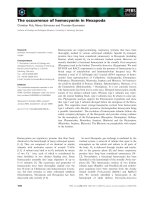
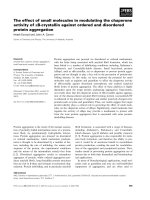
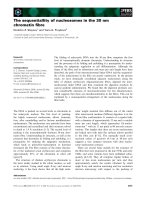
![Tài liệu Báo cáo khoa học: The stereochemistry of benzo[a]pyrene-2¢-deoxyguanosine adducts affects DNA methylation by SssI and HhaI DNA methyltransferases pptx](https://media.store123doc.com/images/document/14/br/gc/medium_Y97X8XlBli.jpg)
